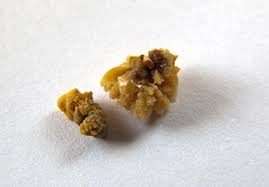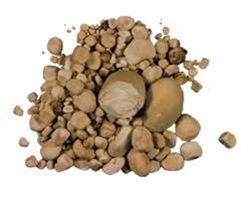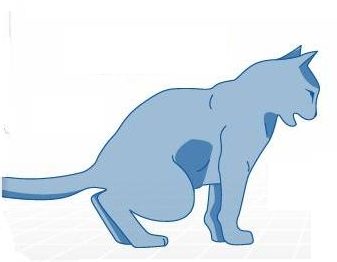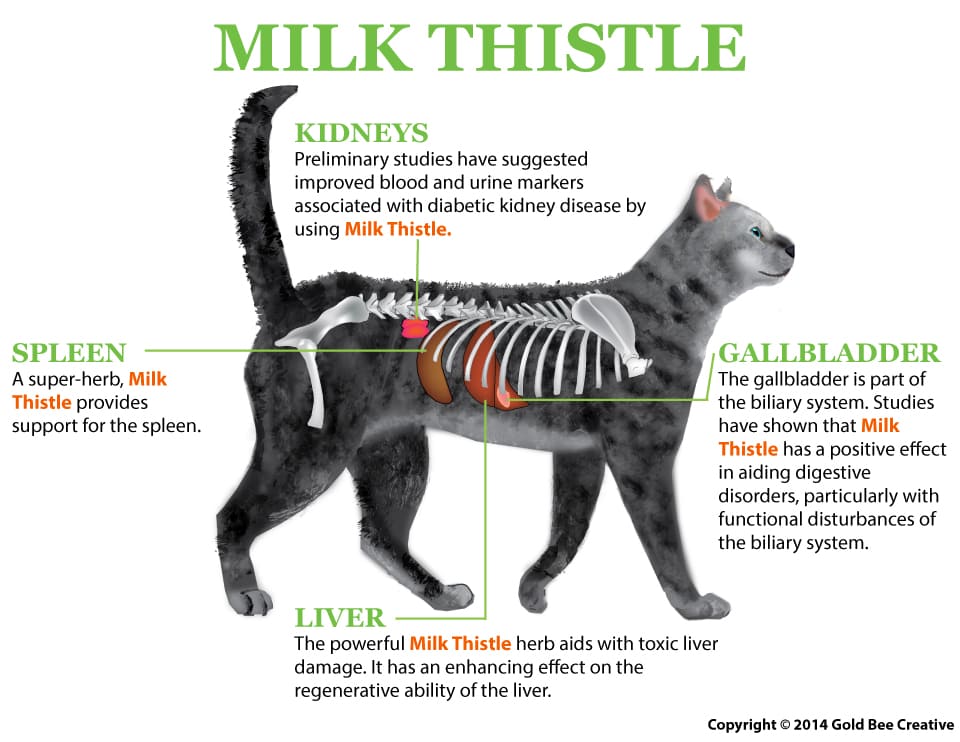kidney & bladder support


free shipping over $100 (USA & Canada)
1-877-937-4372 the pet expert hotline

These are aggregations of minerals and other substances in the bladder. Both the symptoms of bladder stones in cats and dogs, as well as the types of bladder stones can vary. If you think your pet may have bladder stones, it’s best to schedule an appointment with their veterinarian as soon as possible.
Struvite stones (triple magnesium phosphate), occur in the presence of bladder infections. Female dogs are more predisposed to struvite stones than males.

Struvite stone
Calcium oxalate stones occur with higher frequency in certain breeds of dogs. These breeds include the Miniature Schnauzer, Shih Tzu, Bichon Frise, Lhasa Apso, Yorkshire Terrier, and Miniature Poodle. They may also develop as a result of other diseases, such as hyperadrenocorticism (Cushing’s disease) or hypercalcemia (high blood calcium).

Calcium oxalate stones
Urate stones occur with liver problems, such as portosystemic vascular shunts and other inherited defects of the liver.

Uric stones
A complex interaction between the animal’s diet and stone formation affects the development of bladder stones in cats. The two most common types of bladder stones in cats are calcium oxalate stones and struvite stones. Calcium oxalate stones occur more frequently with acidic urine, while struvite stones are more likely to develop in alkaline urine. Urate stones are uncommon in cats and are usually associated with liver or vascular shunts. Other types of bladder stones are rare in cats.
Dogs: Some of the symptoms include frequent urination, urinating urgently, small volumes of urine, and painful urination. Blood may occur throughout the urine stream or may be worse at the end. Bladder stones may become lodged in the urethra, causing a blockage. Urinary obstruction from stones is more common in male dogs.
Cats: Symptoms of bladder stones in cats include frequent trips to the litter box, small volumes of urine, blood in the urine, pain during urination, and urinating outside the litter box. Like in dogs, bladder stones may lodge in the urethra causing a complete urinary obstruction. Urinary obstruction is more common in male cats.
Important: Signs of obstruction include abdominal pain and straining to urinate without producing any urine. Just remember that urinary obstruction is an emergency and requires immediate attention from a veterinarian!

The diagnostic tests for all types of bladder stones in dogs and cats include routine blood and urine tests. Also, abdominal ultrasound and X-rays may be needed in addition to the other tests.
The diet plays an important role with some bladder stones. For example, struvite stones can often be dissolved by a special prescription diet for your pet. However, your pet must eat the prescription diet exclusively. Unfortunately, calcium oxalate stones cannot be dissolved with dietary changes or medication. The only effective therapy is the physical removal of the stones. With other types of stones, medications may be able to dissolve them.
Depending on the type of bladder stone, diet changes may be necessary. It can be a homemade diet formulated by a veterinarian or a commercial prescription diet. Also, if surgery is necessary, preventive measures such as including moist food may be advised. Generally, the prognosis for bladder stones in cats and dogs is excellent.
Tripsy for Dogs and Cats: This supplement is a soothing formula that controls infection. It has a demulcent effect to help reduce the irritation from urinary calculi, and supports the health of the kidneys and bladder.
NHV Milk Thistle for Cats and Dogs: This plant detoxifies the liver and kidneys by removing toxins that can build up in a pet`s system from pharmaceuticals or chemical-laden foods. It improves liver and kidney function, supports regeneration of the liver, and supports overworked kidneys as well It. also has antioxidant properties and may offer anticancer support.
Turmeric for Dogs and Cats: This versatile extract has anti-inflammatory and nutritive properties that increase overall vitality. It can help support pets with a variety of health conditions such as cancer, heart disease, and arthritis. NHV Turmeric for Dogs and Cats is available, along with formulas for some other types of pets.
kidney & bladder support


Support for urinary tract, kidney, and bladder problems in dogs
buy 2 and save $3
3 month supply for a small to medium size

NHV’s Tripsy™ is specially formulated to contain gentle and effective herbal ingredients that help encourage healthy kidney function, proper urinary health and may help with discomfort associated with kidney problems.
When dogs get urinary tract and kidney disorders, it can be very uncomfortable. Poor diets can contribute to kidney stones and even kidney failure, so supporting your canine with supplements that can help is imperative.
NHV Tripsy helps the body stay balanced in many ways. Here are four main organs that may benefit from this gentle kidney support blend.
Powerful Ingredients Effectively Formulated
Read about a recent study done at the University of Georgia College of Veterinary Medicine that found that NHV’s Tripsy, may be beneficial in helping against urinary stone formation.
All NHV’s supplements including those for dog bladder problems are safe to be given along with any vet prescribed medications and are third-party tested to guarantee quality and concentration.
Connect With NHV
If you have questions or concerns about holistic supplements, ask an NHV expert because our pet experts are here to help offer guidance and support for any health issues your pet may have including kidney problems in dogs. At NHV, your dog’s health and well-being is our top priority.
Stone Root – Acts as a tonic for the capillaries and prevents the formation of kidney calculi.
Parsley Piert – Aids digestion. Also used to aid fever, kidney stones, bladder stones, and fluid retention.
Wild Hydrangea – Can help relieve discomfort while increasing the flow of urine and eliminating swelling and fluid retention.
Gravel Root – Restores and cleanses the genitourinary (reproductive and urinary) organs.
Echinacea Purpurea – Contains strong immune-stimulating properties.
Marshmallow – An anti-inflammatory that controls bacterial infections and soothes and softens irritated tissues.
Oregon Grape – Helps relieve indigestion and malabsorption. Also has antibiotic and immunostimulatory properties.
Select your pet's weight to determine the correct dose.
To be taken twice daily. Determine your pet’s weight and then use the easy chart below to determine the correct dose. This is the minimum dosage.
Pet's Weight Dosage
0 - 15 lb = 0.5 ml
16 - 30 lb = 1.0 ml
31 - 45 lb = 1.5 ml
46 - 60 lb = 2.0 ml
61 - 75 lb = 2.5 ml
Over 75 lb = 3.0 ml
How to Administer
Shake well before use. The easiest method is to use the dropper provide and places the drops into your pet’s food or favorite treat. You can also use the dropper and squirt directly into the pet’s mouth.
Some pets can be finicky, if this occurs consider hiding the drops in foods most pet’s love such as fish, chicken or yogurt or a favorite treat. If your pet only eats dry food then soak a few kibbles at feeding time.
For Best Results
Herbal dietary supplements are beneficial to the health and wellbeing of your pet and are safe for long-term use. Every pet responds to natural herbal supplements differently, therefore it is important to be consistent and administer the product daily. Supplements generally take two to four weeks to take effect, however this will vary from one animal to the next.
Product Storage
All NHV Natural Pet Products are pure herbal extracts and contain no artificial additives, preservatives or coloring. Shelf life after opening is 6 months and must be refrigerated after opening.
Cautions and Contraindications
Do not use Tripsy if your pet is pregnant. No known side effects. Speak to your vet before using our products. A second visit is recommended if your pet’s condition does not improve, or deteriorates after continued use of the supplements.
All information provided by NHV Natural Pet Products is for educational purposes only.
NHV’s Tripsy™ is specially formulated to contain gentle and effective herbal ingredients that help encourage healthy kidney function, proper urinary health and may help with discomfort associated with kidney problems.
When dogs get urinary tract and kidney disorders, it can be very uncomfortable. Poor diets can contribute to kidney stones and even kidney failure, so supporting your canine with supplements that can help is imperative.
NHV Tripsy helps the body stay balanced in many ways. Here are four main organs that may benefit from this gentle kidney support blend.
Powerful Ingredients Effectively Formulated
Read about a recent study done at the University of Georgia College of Veterinary Medicine that found that NHV’s Tripsy, may be beneficial in helping against urinary stone formation.
All NHV’s supplements including those for dog bladder problems are safe to be given along with any vet prescribed medications and are third-party tested to guarantee quality and concentration.
Connect With NHV
If you have questions or concerns about holistic supplements, ask an NHV expert because our pet experts are here to help offer guidance and support for any health issues your pet may have including kidney problems in dogs. At NHV, your dog’s health and well-being is our top priority.
Stone Root – Acts as a tonic for the capillaries and prevents the formation of kidney calculi.
Parsley Piert – Aids digestion. Also used to aid fever, kidney stones, bladder stones, and fluid retention.
Wild Hydrangea – Can help relieve discomfort while increasing the flow of urine and eliminating swelling and fluid retention.
Gravel Root – Restores and cleanses the genitourinary (reproductive and urinary) organs.
Echinacea Purpurea – Contains strong immune-stimulating properties.
Marshmallow – An anti-inflammatory that controls bacterial infections and soothes and softens irritated tissues.
Oregon Grape – Helps relieve indigestion and malabsorption. Also has antibiotic and immunostimulatory properties.
Select your pet's weight to determine the correct dose.
To be taken twice daily. Determine your pet’s weight and then use the easy chart below to determine the correct dose. This is the minimum dosage.
Pet's Weight Dosage
0 - 15 lb = 0.5 ml
16 - 30 lb = 1.0 ml
31 - 45 lb = 1.5 ml
46 - 60 lb = 2.0 ml
61 - 75 lb = 2.5 ml
Over 75 lb = 3.0 ml
How to Administer
Shake well before use. The easiest method is to use the dropper provide and places the drops into your pet’s food or favorite treat. You can also use the dropper and squirt directly into the pet’s mouth.
Some pets can be finicky, if this occurs consider hiding the drops in foods most pet’s love such as fish, chicken or yogurt or a favorite treat. If your pet only eats dry food then soak a few kibbles at feeding time.
For Best Results
Herbal dietary supplements are beneficial to the health and wellbeing of your pet and are safe for long-term use. Every pet responds to natural herbal supplements differently, therefore it is important to be consistent and administer the product daily. Supplements generally take two to four weeks to take effect, however this will vary from one animal to the next.
Product Storage
All NHV Natural Pet Products are pure herbal extracts and contain no artificial additives, preservatives or coloring. Shelf life after opening is 6 months and must be refrigerated after opening.
Cautions and Contraindications
Do not use Tripsy if your pet is pregnant. No known side effects. Speak to your vet before using our products. A second visit is recommended if your pet’s condition does not improve, or deteriorates after continued use of the supplements.
All information provided by NHV Natural Pet Products is for educational purposes only.
kidney & bladder support

Supplement for kidney, renal and bladder problems in cats
buy 2 and save $3
3 month supply for a small to medium size

Specially formulated to gently and effectively promote proper urinary health as well as easing uncomfortable urination that often accompanies kidney problems in cats. With seven powerful ingredients, this supplement is highly effective in helping your cat’s urinary system.
NHV Tripsy for kidney problems in cats also helps to:
Many cats can suffer from kidney, renal and urinary disorders that can be uncomfortable. Kidney stones form when the body is unable to properly metabolize minerals due to a poor diet. If untreated, this may eventually lead to kidney failure, so making sure your feline family member gets adequate nutrition is vital.
NHV’s Tripsy is also safe to be given along with conventional treatments for kidney problems in cats. You can read about a recent evaluation done on the healing components of this powerful supplemental blend and how it alleviates bladder problems in cats.
Finding the right blend of kidney supplements for cats is easy online at NHV. If you have questions or concerns, you can always schedule a consultation because at NHV we want to provide you with the best service to help your cat live a healthy purrfect life naturally.
Stone Root – Acts as a tonic for the capillaries and prevents the formation of kidney calculi.
Parsley Piert – Aids digestion. Also used to aid fever, kidney stones, bladder stones and fluid retention.
Wild Hydrangea – May help with discomfort while increasing the flow of urine and eliminating swelling and fluid retention.
Gravel Root – Restores and cleanses the genitourinary (reproductive and urinary) organs.
Echinacea Purpurea – Contains strong immune-stimulating properties.
Marshmallow – An anti-inflammatory that controls bacterial infections and soothes and softens irritated tissues.
Oregon Grape – Helps relieve indigestion and malabsorption. Also has antibiotic and immunostimulatory properties.
Select your pet's weight to determine the correct dose.
To be taken twice daily. Determine your pet’s weight and then use the easy chart below to determine the correct dose. This is the minimum dosage.
Pet's Weight Dosage
0 - 15 lb = 0.5 ml
16 - 30 lb = 1.0 ml
31 - 45 lb = 1.5 ml
46 - 60 lb = 2.0 ml
61 - 75 lb = 2.5 ml
Over 75 lb = 3.0 ml
How to Administer
Shake well before use. The easiest method is to use the dropper provide and places the drops into your pet’s food or favorite treat. You can also use the dropper and squirt directly into the pet’s mouth.
Some pets can be finicky, if this occurs consider hiding the drops in foods most pet’s love such as fish, chicken or yogurt or a favourite treat. If your pet only eats dry food then soak a few kibbles at feeding time.
For Best Results
Herbal dietary supplements are beneficial to the health and wellbeing of your pet and are safe for long-term use. Every pet responds to natural herbal supplements differently, therefore it is important to be consistent and administer the product daily. Supplements generally take two to four weeks to take effect, however this will vary from one animal to the next.
Product Storage
All NHV Natural Pet Products are pure herbal extracts and contain no artificial additives, preservatives or coloring. Shelf life after opening is 6 months and must be refrigerated after opening.
Cautions and Contraindications
Do not use Tripsy if your pet is pregnant. No known side effects. Speak to your vet before using our products. A second visit is recommended if your pet’s condition does not improve, or deteriorates after continued use of the supplements.
All information provided by NHV Natural Pet Products is for educational purposes only.
Specially formulated to gently and effectively promote proper urinary health as well as easing uncomfortable urination that often accompanies kidney problems in cats. With seven powerful ingredients, this supplement is highly effective in helping your cat’s urinary system.
NHV Tripsy for kidney problems in cats also helps to:
Many cats can suffer from kidney, renal and urinary disorders that can be uncomfortable. Kidney stones form when the body is unable to properly metabolize minerals due to a poor diet. If untreated, this may eventually lead to kidney failure, so making sure your feline family member gets adequate nutrition is vital.
NHV’s Tripsy is also safe to be given along with conventional treatments for kidney problems in cats. You can read about a recent evaluation done on the healing components of this powerful supplemental blend and how it alleviates bladder problems in cats.
Finding the right blend of kidney supplements for cats is easy online at NHV. If you have questions or concerns, you can always schedule a consultation because at NHV we want to provide you with the best service to help your cat live a healthy purrfect life naturally.
Stone Root – Acts as a tonic for the capillaries and prevents the formation of kidney calculi.
Parsley Piert – Aids digestion. Also used to aid fever, kidney stones, bladder stones and fluid retention.
Wild Hydrangea – May help with discomfort while increasing the flow of urine and eliminating swelling and fluid retention.
Gravel Root – Restores and cleanses the genitourinary (reproductive and urinary) organs.
Echinacea Purpurea – Contains strong immune-stimulating properties.
Marshmallow – An anti-inflammatory that controls bacterial infections and soothes and softens irritated tissues.
Oregon Grape – Helps relieve indigestion and malabsorption. Also has antibiotic and immunostimulatory properties.
Select your pet's weight to determine the correct dose.
To be taken twice daily. Determine your pet’s weight and then use the easy chart below to determine the correct dose. This is the minimum dosage.
Pet's Weight Dosage
0 - 15 lb = 0.5 ml
16 - 30 lb = 1.0 ml
31 - 45 lb = 1.5 ml
46 - 60 lb = 2.0 ml
61 - 75 lb = 2.5 ml
Over 75 lb = 3.0 ml
How to Administer
Shake well before use. The easiest method is to use the dropper provide and places the drops into your pet’s food or favorite treat. You can also use the dropper and squirt directly into the pet’s mouth.
Some pets can be finicky, if this occurs consider hiding the drops in foods most pet’s love such as fish, chicken or yogurt or a favourite treat. If your pet only eats dry food then soak a few kibbles at feeding time.
For Best Results
Herbal dietary supplements are beneficial to the health and wellbeing of your pet and are safe for long-term use. Every pet responds to natural herbal supplements differently, therefore it is important to be consistent and administer the product daily. Supplements generally take two to four weeks to take effect, however this will vary from one animal to the next.
Product Storage
All NHV Natural Pet Products are pure herbal extracts and contain no artificial additives, preservatives or coloring. Shelf life after opening is 6 months and must be refrigerated after opening.
Cautions and Contraindications
Do not use Tripsy if your pet is pregnant. No known side effects. Speak to your vet before using our products. A second visit is recommended if your pet’s condition does not improve, or deteriorates after continued use of the supplements.
All information provided by NHV Natural Pet Products is for educational purposes only.
liver support

100% Natural Liver and Kidney Detox and Cancer Support in Cats
buy 2 and save $3
3 month supply for a small to medium size pet
A popular herb among conventional and holistic veterinarians, Milk Thistle is often recommended for cats who have liver disorders, are fighting cancer, diabetes, kidney issues, gallbladder and bile duct issues, as well as hyperthyroidism.


A popular herb among conventional and holistic veterinarians, Milk Thistle is often recommended for cats who have liver disorders, are fighting cancer, diabetes, kidney issues, gallbladder and bile duct issues, as well as hyperthyroidism.

Milk thistle, also known as Silybum Marianum is an herb that has been used for thousands of years by humans for its powerful medicinal properties. The active ingredient is Silymarin which contains flavonoids that have many beneficial properties including:
Milk thistle is one of the few herbs that have no equivalent in conventional medicine and has many uses. You can read about the many applications of Milk Thistle for cats and dogs on Dr. Hillary Cook's blog.
Milk Thistle for Liver Function
Milk Thistle for cats with liver disease is glycerin-based and safe for long-term use. This potent herbal formula provides excellent proactive support and can be taken in conjunction with conventional treatment.
Milk Thistle for Kidney Function
Milk Thistle for Anti-Cancer Support
Milk Thistle may also be beneficial to cats undergoing chemotherapy as Silymarium may enhance the activity of certain chemo drugs.
You can read Peachez's Story with Milk Thistle for cats and how it helped her with cancer and liver problems.
NHV’s certified organic Milk Thistle is a safe herb that is recommended and used by holistic practitioners. All of our products are all-natural and formulated by veterinarians with a focus on comprehensively supporting the health and well-being of your feline family member.
If you have questions about Milk Thistle or any of our plant-based products, ask an NHV expert because at NHV we want your kitty’s health to be purrfect!

NHV’s Milk Thistle for Cats contains just one ingredient.
Select your pet's weight to determine the correct dose.
To be taken twice daily. Determine your pet’s weight and then use the easy chart below to determine the correct dose. This is the minimum dosage.
Pet's Weight Dosage
0 - 15 lb = 0.5 ml
16 - 30 lb = 1.0 ml
31 - 45 lb = 1.5 ml
46 - 60 lb = 2.0 ml
61 - 75 lb = 2.5 ml
Over 75 lb = 3.0 ml
How to Administer
Shake well before use. The easiest method is to use the dropper provide and places the drops into your pet’s food or favorite treat. You can also use the dropper and squirt directly into the pet’s mouth.
Some pets can be finicky, if this occurs consider hiding the drops in foods most pet’s love such as fish, chicken or yogurt or a favorite treat. If your pet only eats dry food then soak a few kibbles at feeding time.
For Best Results
Herbal dietary supplements are beneficial to the health and wellbeing of your pet and are safe for long-term use. Every pet responds to natural herbal supplements differently, therefore it is important to be consistent and administer the product daily. Supplements generally take two to four weeks to take effect, however this will vary from one animal to the next.
Product Storage
All NHV Natural Pet Products are pure herbal extracts and contain no artificial additives, preservatives or coloring. Shelf life after opening is 6 months and must be refrigerated after opening.
Cautions and Contraindications
Do not use Milk Thistle in pregnant or nursing animals. Speak to your vet before using our products. A second visit is recommended if your pet’s condition does not improve, or deteriorates after continued use of the supplements.
All information provided by NHV Natural Pet Products is for educational purposes only.
Milk thistle, also known as Silybum Marianum is an herb that has been used for thousands of years by humans for its powerful medicinal properties. The active ingredient is Silymarin which contains flavonoids that have many beneficial properties including:
Milk thistle is one of the few herbs that have no equivalent in conventional medicine and has many uses. You can read about the many applications of Milk Thistle for cats and dogs on Dr. Hillary Cook's blog.
Milk Thistle for Liver Function
Milk Thistle for cats with liver disease is glycerin-based and safe for long-term use. This potent herbal formula provides excellent proactive support and can be taken in conjunction with conventional treatment.
Milk Thistle for Kidney Function
Milk Thistle for Anti-Cancer Support
Milk Thistle may also be beneficial to cats undergoing chemotherapy as Silymarium may enhance the activity of certain chemo drugs.
You can read Peachez's Story with Milk Thistle for cats and how it helped her with cancer and liver problems.
NHV’s certified organic Milk Thistle is a safe herb that is recommended and used by holistic practitioners. All of our products are all-natural and formulated by veterinarians with a focus on comprehensively supporting the health and well-being of your feline family member.
If you have questions about Milk Thistle or any of our plant-based products, ask an NHV expert because at NHV we want your kitty’s health to be purrfect!

NHV’s Milk Thistle for Cats contains just one ingredient.
Select your pet's weight to determine the correct dose.
To be taken twice daily. Determine your pet’s weight and then use the easy chart below to determine the correct dose. This is the minimum dosage.
Pet's Weight Dosage
0 - 15 lb = 0.5 ml
16 - 30 lb = 1.0 ml
31 - 45 lb = 1.5 ml
46 - 60 lb = 2.0 ml
61 - 75 lb = 2.5 ml
Over 75 lb = 3.0 ml
How to Administer
Shake well before use. The easiest method is to use the dropper provide and places the drops into your pet’s food or favorite treat. You can also use the dropper and squirt directly into the pet’s mouth.
Some pets can be finicky, if this occurs consider hiding the drops in foods most pet’s love such as fish, chicken or yogurt or a favorite treat. If your pet only eats dry food then soak a few kibbles at feeding time.
For Best Results
Herbal dietary supplements are beneficial to the health and wellbeing of your pet and are safe for long-term use. Every pet responds to natural herbal supplements differently, therefore it is important to be consistent and administer the product daily. Supplements generally take two to four weeks to take effect, however this will vary from one animal to the next.
Product Storage
All NHV Natural Pet Products are pure herbal extracts and contain no artificial additives, preservatives or coloring. Shelf life after opening is 6 months and must be refrigerated after opening.
Cautions and Contraindications
Do not use Milk Thistle in pregnant or nursing animals. Speak to your vet before using our products. A second visit is recommended if your pet’s condition does not improve, or deteriorates after continued use of the supplements.
All information provided by NHV Natural Pet Products is for educational purposes only.